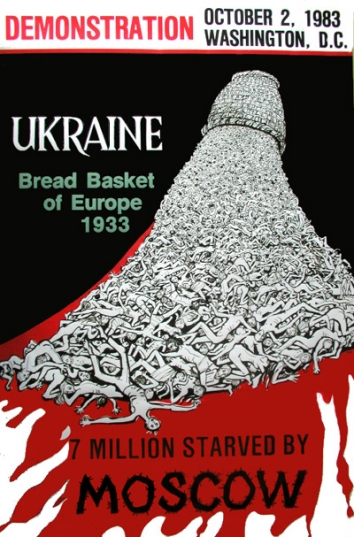Featured Galleries USUBC COLLECTION OF OVER 160 UKRAINE HISTORIC NEWS PHOTOGRAPHS 1918-1997
 Holodomor Posters
Holodomor Posters

Q3 global power and utility deals hit by valuation concerns
 Ernst & Young LLC, Kyiv, Ukraine
Ernst & Young LLC, Kyiv, Ukraine
22 November, 2012
- Deal value dives 60% quarter-on-quarter, while volume drops 12%
- Total value in 2012 likely to fall short of 2011
- 79% of P&U executives say deal size limited to US$500m in the next year
LONDON, 22 NOVEMBER 2012. Following a bumper Q2 of deal-making in the global power and utilities (P&U) sector, Q3 saw mergers and acquisitions (M&A) values in the sector decline by 60% (US$19b compared to US$47.9b in Q2) and volumes of activity down by 12% (68 compared to 77 in Q2), as the growing valuation gap between buyers and sellers proves the major barrier to deal completions, together with a significant decline in European and Asia-Pacific deal activity. That is according to Ernst & Young’s quarterly Power Transactions and Trends report.
Unlike last quarter, which witnessed eight billion-dollar-plus deals (including four over US$3b), Q3 2012 saw only four deals over a billion dollars. Average deal value was US$352m, a decline of 59% compared to Q2 2012.
M&A value for the year has only reached US$92.9b so far and it looks set that 2012 M&A will fall short of the US$144.7b achieved in 2011.
Joseph Fontana, Ernst & Young Global Transaction Advisory Power and Utilities Leader, says:
“The fall-off in deal activity can be largely attributed to renewed global economic uncertainty, delays in privatization and divestment programs in Europe, as well as a growing valuation gap between buyers and sellers, which has led to failed deal discussions. Although divestments and unbundling requirements in Europe will keep Asian investors active in the coming quarter, the fear of not getting the right valuations might drive sellers to hold on to their assets, and continue to restrict M&A activity.”
US on the rise while European dominance ends
Europe’s long dominance over global P&U deal value ended in Q3 2012, with transaction value declining 71% compared to Q2 and 64% compared to the same period last year. Americas, on the other hand, saw deal volume more than double compared to the previous quarter, while value increased 66% compared to Q2 and over 100% on Q3 2011, driven by large generation segment deals in the US.
Fontana says: “Europe witnessed several failed deal discussions between buyers and sellers due to a combination of asset valuation gaps and some tougher financing conditions in Western Europe. The ripple effect was seen on Asia-Pacific deal activity, whose investors, specifically Asian funds, are the likely buyers of European utility assets.
“Despite the challenges, we expect European M&A to regain momentum, driven by announced company divestments and government privatization programs, albeit at a potentially slower pace than originally expected. Greek and Czech privatizations seem to be moving forward and may land in the next quarter or two.”
Generation and waste management driving deals
Renewed interest in the Americas generation sector made it a dominant sector segment in Q3 2012, with value up by 45% on the previous quarter. Renewables deal value was down 19% on the previous quarter due to the absence of large value deals, however, deal volume was up 7% on the back of a rise in wind energy transactions. Waste management transactions drove the overall deal activity of the segment contributing over 55% to the total deal value, led by Veolia’s US$1.9b divestment of Veolia ES Solid Waste, Inc. to US-based Star Atlantic Waste Holdings, LP.
Deal sizes to fall in next 12 months
Looking ahead, Ernst & Young’s newly released Capital Confidence Barometer for Power & Utilities, a survey of over 1500 global executives on M&A appetite, which included 171 respondents from the sector, shows 80% of power and utility executives think the global economy shows no signs of improvement and large transformation deals are off the table, with 79% of power and utilities executives saying the size of any M&A they do in the coming year will be below US$500m.
Fontana says: “Declining global economic confidence is a key barrier to the execution of the billion-dollar deals, and until we see clearer resolutions in Europe, greater transparency of Chinese growth, and a rebound in the US labor and housing market, we are unlikely to see the mega-deals return.”
A valuation gap between buyers and sellers is the key deterrent to M&A with 38% of sector respondents citing the valuation gap between buyers and sellers at 10–20%; 66% believe it is greater than 10%.
Prioritization of growth has declined for power and utility executives around the globe. Despite remaining a primary goal (40% say it’s their focus), the percentage of power and utilities executives focusing on growth has fallen to 40% from 48% six months ago and 71% two years ago. In its place is a renewed focus on fundamentals of reducing costs and improving efficiency, particularly in the Eurozone and parts of Asia-Pacific.
Global outlook
Fontana concludes: “We have a stand-off between buyers and sellers. Buyers think assets are overpriced, and the sellers are less willing to divest. It remains to be seen who will blink first.
“However, there is general consensus that the market is stable. The fundamentals are in place for transactions that make strategic sense. The big deals might be on the back burner for now, but we still anticipate robust activity from financial buyers and the potential for some big mergers where it strategically makes sense. With reasonable credit availability and stockpiled cash, M&A in this industry is not dead — it’s just playing a waiting game.”











